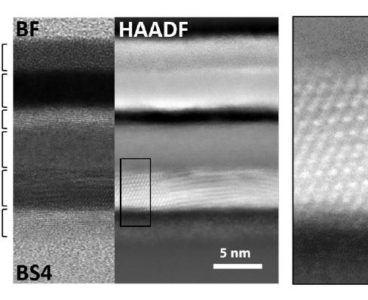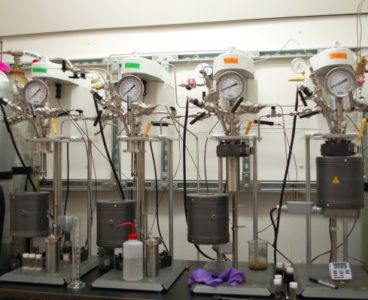A team of researchers from the University of Minnesota and University of Massachusetts Amherst has discovered new technology that can speed up chemical reactions 10,000 times faster than the current reaction rate limit. These findings could increase the speed and lower the cost of thousands of chemical processes used in developing fertilizers, foods, fuels, plastics,…
Graphene-based Device Paves the Way for Ultrasensitive Biosensors
Researchers in the University of Minnesota College of Science and Engineering have developed a unique new device using the wonder material graphene that provides the first step toward ultrasensitive biosensors to detect diseases at the molecular level with near perfect efficiency. Ultrasensitive biosensors for probing protein structures could greatly improve the depth of diagnosis for…
Researchers Discover How to Slow Aging
New Material Could Improve Efficiency of Computer Processing and Memory
A team of researchers led by the University of Minnesota has developed a new material that could potentially improve the efficiency of computer processing and memory. The researchers have filed a patent on the material with support from the Semiconductor Research Corporation, and people in the semiconductor industry have already requested samples of the material.…
To Beat Cancer, Put a Nanoring on It
Can we use nanotechnology to transform our own immune cells into cancer serial killers? Dr. Carston R. Wagner, professor and endowed chair of the Department of Medicinal Chemistry in the College of Pharmacy and Masonic Cancer Center member, has proven so by his team’s development of techniques that activate immune cells, specifically T-cells, to track…
Silicon Nanoparticles Enlisted to Fight Infections
There is an urgent need for better methods to treat bacterial infection in the race between developing new antibiotics and the emergence of drug-resistant bacteria. Presently, antimicrobial resistance is responsible for 23,000 deaths annually in the United States and 700,000 deaths worldwide. A Wellcome Trust 2016 study predicted the present rate of emergence of new…
New Research Shows Fertilization Drives Global Lake Emissions of Greenhouse Gases
A paper published this week in the journal Limnology and Oceanography Letters is the first to show that lake size and nutrients drive how much greenhouse gases are emitted globally from lakes into the atmosphere. “Our research pioneers a new way of determining the global atmospheric effect of lakes using satellite information on lake greenness and size…
New Finding Could Improve Brain-Like Memory, Computing
From various magnetic tapes, floppy disks, and computer hard disk drives, magnetic materials have been storing our electronic information along with our valuable knowledge and memories for well over half of a century. In more recent years, the new types phenomena known as magnetoresistance, which is the tendency of a material to change its electrical…
Artificial Organs Created with 3D Printer
A team of researchers led by the University of Minnesota has 3D printed lifelike artificial organ models that mimic the exact anatomical structure, mechanical properties, and look and feel of real organs. These patient-specific organ models, which include integrated soft sensors, can be used for practice surgeries to improve surgical outcomes in thousands of patients…
Graphene Nano Tweezers Grasp Individual Biomolecules
Researchers from the University of Minnesota College of Science and Engineering have found yet another remarkable use for the wonder material graphene — tiny electronic “tweezers” that can grab biomolecules floating in water with incredible efficiency. This capability could lead to a revolutionary handheld disease diagnostic system that could be run on a smart phone.…
Nanotechnology Allows Faster, Cheaper Detection of Oak Wilt
Oak wilt fungus is another invasive plant pathogen that often goes unnoticed, until it’s too late. Not anymore. New technology developed by University of Minnesota College of Food, Agricultural and Natural Resource Sciences (CFANS) researcher Abdennour Abbas and his team offers a simple, affordable diagnostic test utilizing nanotechnology and gold. Abbas is an assistant professor…
Researchers Transform Conservation Tool with Gold Nanotechnology, Lasers
For more than 60 years, researchers have tried to successfully cryopreserve (or freeze) the embryo of zebrafish, a species that is an important medical model for human health. In a new study, researchers at the University of Minnesota and the Smithsonian Conservation Biology Institute (SCBI) provide the first-ever reproducible evidence for the successful cryopreservation of…
Robots Could Gain Sense of Touch from 3D-Printed “Skin”
Engineering researchers at the University of Minnesota have developed a revolutionary process for 3D printing stretchable electronic sensory devices that could give robots the ability to feel their environment. The discovery is also a major step forward in printing electronics on real human skin. The research will be published in the next issue of Advanced…
3D Printed ‘Bionic Skin’ Could Give Robots The Sense of Touch
Engineering researchers at the University of Minnesota have developed a revolutionary process for 3D printing stretchable electronic sensory devices that could give robots the ability to feel their environment. The discovery is also a major step forward in printing electronics on real human skin. The research will be published in the next issue of Advanced Materials and…
Nanotechnology Used to Thaw Cryogenically Preserved Organs
A research team, led by the University of Minnesota, has discovered a groundbreaking process to successfully rewarm large-scale animal heart valves and blood vessels preserved at very low temperatures. The discovery is a major step forward in saving millions of human lives by increasing the availability of organs and tissues for transplantation through the establishment…
Researchers Invent a Breakthrough Process to Produce Renewable Car Tires From Trees and Grasses
A team of researchers, led by the University of Minnesota, has invented a new technology to produce automobile tires from trees and grasses in a process that could shift the tire production industry toward using renewable resources found right in our backyards. Conventional car tires are viewed as environmentally unfriendly because they are predominately made…
Researchers Provide Molecular Portraits of New Cancer Drug Target
New Discovery Could Help Oral Medicines Work Better
A team of researchers from the University of Minnesota and The Dow Chemical Company have discovered a new method for customizing ingredients that help oral medications dissolve in the body and be absorbed into the bloodstream. The materials discovered in this study could allow life-saving drugs to work faster and more efficiently. The University of…
“Perfect” Soap Molecule Could Revolutionize Cleaning Industry
A team of researchers, led by the University of Minnesota, has invented a new soap molecule made from renewable sources that could dramatically reduce the number of chemicals in cleaning products and their impact on the environment. The soap molecules also worked better than some conventional soaps in challenging conditions such as cold water and…
Researchers Invent ‘Perfect’, Environmentally-Friendly Soap Molecule
Photons Do the Twist, and Scientists Can Now Measure It
Researchers in the University of Minnesota’s College of Science and Engineering have measured the twisting force, or torque, generated by light on a silicon chip. Their work holds promise for applications such as miniaturized gyroscopes and torsional sensors to measure magnetic field, which can have significant industrial and consumer impact. The new study, entitled “Optomechanical…












